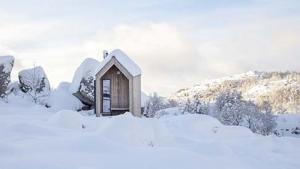 With no road access, this emergency shelter in the Norwegian mountains was assembled to be almost maintenance-free. Ines Nastali reports.
With no road access, this emergency shelter in the Norwegian mountains was assembled to be almost maintenance-free. Ines Nastali reports.
If you ever find yourself snowed under around Norway’s Preikestolen, Pulpit Rock – one of the country’s most popular tourist attractions – you can now find shelter in a purpose-built cabin.
The Preikestolen lodge is the first of two emergency cabins funded by a state grant of 300,000NOK (£28,000), with additional support received from the national SR Bank foundation. Up to 10 people can find shelter in the house, which can only be accessed after people in need have made a call to emergency services, ensuring the cabin is used strictly in an emergency.
MyBox, the main contractor, is a specialist in micro housing and was responsible for the delivery and project management of the Preikestolen cabin. ‘Meticulous planning was required for the construction due to its remote location,’ the company states in a press release, adding that ‘with no road access, all materials were transported by helicopter over the summer months to ensure the build was completed before the early dark nights and storms arrived in autumn’. The exposed location, 604m above the Lysefjord, prompted builder Scandihus to select cladding from Norwegian company Kebony. The wooden cladding is made from Pinus sylvestris, Scots pine, and is resistant to wear and weathering, therefore requiring no maintenance beyond normal cleaning. It also adopts a silver-grey patina over time and after exposure to sun and rain, making the cabin blend in with the large, rocky landscape.
‘Developed in Norway, the patented Kebony technology uses an environmentally friendly process, which permanently enhances the properties of sustainable softwood with a bio-based liquid, primarily based on furfuryl alcohol, derived from agricultural crop waste, which is a bi-product from sugar cane production,’ a spokesperson for Kebony told Materials World. ‘By polymerising the wood’s cell walls, it gains improved durability and dimensional stability, giving it characteristics similar to those of tropical hardwood,’ Kebony states.
Powered up
Solar cells have been installed throughout the cabin to provide a sustainable power supply, in addition to a wood-burning stove, which can be fired up when the temperature drops.
The second cabin will be built at Neverdalskaret, on top of the steep Steinura, to provide a safe shelter for tourists who have been injured when hiking or to protect them from the extreme Nordic weather conditions.
(iom3)
